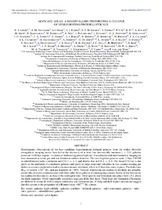| dc.contributor.author | Ivison, R.J. | |
| dc.contributor.author | Swinbank, A.M. | |
| dc.contributor.author | Jarvis, Matt | |
| dc.date.accessioned | 2016-03-13T17:55:18Z | |
| dc.date.available | 2016-03-13T17:55:18Z | |
| dc.date.issued | 2013 | |
| dc.identifier.citation | Ivison, R.J. et al. (2013). Herschel-ATLAS: A binary HyLIRG pinpointing a cluster of starbursting protoellipticals. The Astrophysical Journal, 772(2): 137 | en_US |
| dc.identifier.issn | 0004-637x | |
| dc.identifier.uri | http://hdl.handle.net/10566/2088 | |
| dc.description.abstract | Panchromatic observations of the best candidate hyperluminous infrared galaxies from the widest Herschel
extragalactic imaging survey have led to the discovery of at least four intrinsically luminous z = 2.41 galaxies
across an ≈100 kpc region—a cluster of starbursting protoellipticals. Via subarcsecond interferometric imaging we
have measured accurate gas and star formation surface densities. The two brightest galaxies span ∼3 kpc FWHM
in submillimeter/radio continuum and CO J = 4–3, and double that in CO J = 1–0. The broad CO line is due
partly to the multitude of constituent galaxies and partly to large rotational velocities in two counter-rotating gas
disks—a scenario predicted to lead to the most intense starbursts, which will therefore come in pairs. The disks have
Mdyn of several ×1011M , and gas fractions of ∼40%. Velocity dispersions are modest so the disks are unstable,
potentially on scales commensurate with their radii: these galaxies are undergoing extreme bursts of star formation,
not confined to their nuclei, at close to the Eddington limit. Their specific star formation rates place them 5×above
the main sequence, which supposedly comprises large gas disks like these. Their high star formation efficiencies
are difficult to reconcile with a simple volumetric star formation law. N-body and dark matter simulations suggest
that this system is the progenitor of a B(inary)-type ≈1014.6-M cluster. | en_US |
| dc.language.iso | en | en_US |
| dc.publisher | American Astronomical Society | en_US |
| dc.rights | AAS grants back to authors the non-exclusive right of republication, subject only to giving appropriate credit to the journal in which the article was published. This non-exclusive right of republication gives authors the right to approve or deny reproduction of all or part of the article and to post the final published version online. | |
| dc.source.uri | http://dx.doi.org/10.1088/0004-637X/772/2/137 | |
| dc.subject | Astrophysics | en_US |
| dc.subject | Galaxies | en_US |
| dc.subject | Panchromatic observations | en_US |
| dc.subject | Herschel | en_US |
| dc.subject | Radio continuum | en_US |
| dc.subject | Starburst | en_US |
| dc.subject | Submillimeter galaxies | en_US |
| dc.subject | Radio lines | en_US |
| dc.subject | Hyperluminous infrared (IR) galaxies (HyLIRGs) | en_US |
| dc.title | Herschel-ATLAS: A binary HyLIRG pinpointing a cluster of starbursting protoellipticals | en_US |
| dc.type | Article | en_US |
| dc.privacy.showsubmitter | false | |
| dc.status.ispeerreviewed | true | |
| dc.description.accreditation | Web of Science | en_US |

